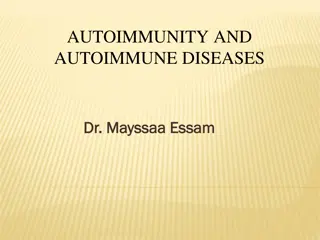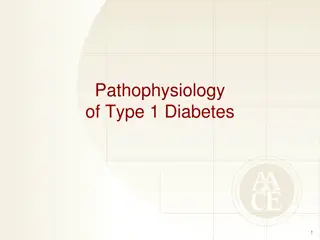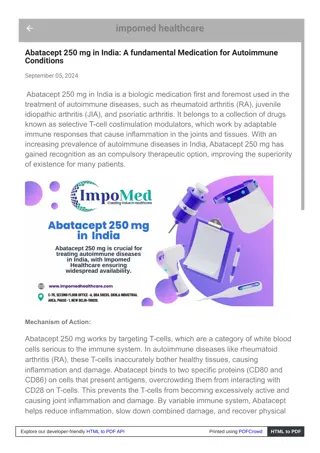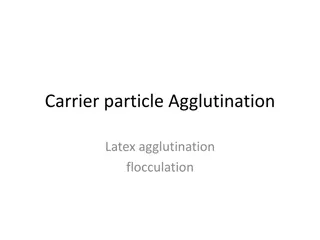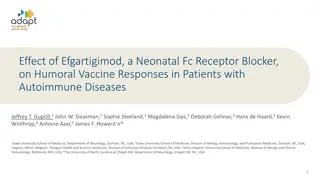Understanding Immunopathological Reactions and Autoimmune Diseases
Discover the classification of immunopathological reactions by Gell and Coombs, including Type I to IV reactions, with insights into allergic diseases, anaphylaxis, drug allergy, and autoimmune diseases like Graves' disease and Myasthenia gravis.
Download Presentation

Please find below an Image/Link to download the presentation.
The content on the website is provided AS IS for your information and personal use only. It may not be sold, licensed, or shared on other websites without obtaining consent from the author. Download presentation by click this link. If you encounter any issues during the download, it is possible that the publisher has removed the file from their server.
E N D
Presentation Transcript
30. Immunopatological reaction type IV (delayed type). Cutaneous and mucous contact allergy. 31. IgE based immunopatological reaction (type I, atopy). 32. Allergens. Allergic diseases - causes, symptoms and diagnostics. 33. Anaphylaxis (causes, symptoms and treatment). 34. Examples of diseases based on immunopathological reaction type I. Treatment. 35. Drug allergy. 36. IgG and IgM based immunopathological reaction (reaction of hypersensitivity type II). 37. Immunocomplex based immunopathological reaction (reaction of hypersensitivity type III).
Immunopathological reactions
Classification by Gell and Coombs Immunopathological reactions: immune response, which causes damage to the body (secondary consequence of defense responses against pathogens, inappropriate responses to harmless antigens, autoimmunity) Four types of immunopathological reactions: Type I reaction - response based on IgE antibodies Type II reaction - response based on antibodies, IgG and IgM Type III reaction- response based on the formation of immune complexes Type IV reaction - cell-mediated response
Immunopathological reactions based on antibodies IgG and IgM (reaction type II) Cytotoxic antibodies IgG and IgM: complement activation binding to Fc receptors on phagocytes and NK cells (ADCC)
Examples of immunopathological reaction Type II Post-transfusion reactions after administration of incompatibile blood: binding of antibodies to antigens on erythrocytes activation of the classical pathway of complement cell lysis Hemolytic disease of newborns: caused by antibodies against RhD antigen
Autoimmune diseases: organ-specific cytotoxic antibodies (antibodies against erythrocytes, neutrophils, thrombocytes, glomerular basement membrane ...) blocking or stimulating antibodies Graves - Basedow's disease - stimulating antibodies against the receptor for TSH Myasthenia gravis - blocking of acetylcholin receptor blocking of neuromuscular transmission Pernicious anemia - blocking the absorption of vitamin B12 Antiphospholipid syndrome - antibodies against fosfolipids Fertility disorder - antibodies against sperms or oocytes
Immunopathological reactions based on immune complexes formation (reaction type III) caused by IgG antibodies bind to antigen creation of immune complexes immunocomplexes - bind to Fc receptors on phagocytes - activate complement immune complexes, depending on the quantity and structure, are eliminated by phagocytes or stored in tissues pathological immunocomplexes response arises when is a large dose of antigen, or antigen in the body remains; arise 10-14 days after aplication of Ag and induced inflamation can get to chronic state immune complexes are deposited in the kidneys (glomerulonephritis), on the surface of endothelial cells (vasculitis) and in synovie joint (arthritis)
Serum sickness the therapeutic application of xenogeneic serum (antiserum to snake venom) creation of immune complexes and their storage in the vessel walls of different organs clinical manifestations: urticaria, arthralgia, myalgia Systemic lupus erythematosus antibodies against nuclear antigens, ANA, anti-dsDNA Farmer's lung (exogenic allergic alveolitis) IgG antibody against inhaled antigens (molds, hay) Post-streptococcal glomerulonephritis, cryoglobulinemia, revmatoid arthritis, post-infectious arthritis
Immunopathological reaction (reaction of hypersensitivity) type I. Allergens - definition, division and nomenclature. Anaphylaxis - pathophysiology, clinical manifestation, treatment. Diagnostic procedures used in allergology. Treatment of allergic diseases. Examples of diseases based on immunopathological reaction of type I.
Mechanism of IgEmediated reaction Type I Allergy + Degranulation, mediator release IgE bound to the surface of the mast cell Allergen
Th1/Th2 response IgE IL-4 B Allergen IL-12 T Th2 T APC IL-5 Allergic reaction Eosinophil IL-12 T Th1 IFN- IgG B
Immunopathological reaction (reaction of hypersensitivity) type I. Allergens - definition, division and nomenclature. Anaphylaxis - pathophysiology, clinical manifestation, treatment. Diagnostic procedures used in allergology. Treatment of allergic diseases. Examples of diseases based on immunopathological reaction of type I.
Inhaled (airborne) Food Allergens Venoms Drugs
EXAMPLES birch grass mugwort ragweed pollen seasonal Inhaled allergens molds Alternaria Cladosporium Aspergillus Dermatophagoides pteronyssinus Dermatophagoides farinae mites perennial animals cat dog
EXAMPLES cow s milk eggs vegetables, fruits, nuts Food allergens fish, seafood aditives AGE
EXAMPLES honey bee (bumble bee) Hymenoptera venom allergens wasp, yellow jacket (hornet)
EXAMPLES penicillines, cephalosporines non-steroidal antiinflammatory drugs iodine contrast media Drug allergens local anesthetics peripheral myorelaxants latex ethylenoxid
Immunopathological reaction (reaction of hypersensitivity) type I. Allergens - definition, division and nomenclature. Anaphylaxis - pathophysiology, clinical manifestation, treatment. Diagnostic procedures used in allergology. Treatment of allergic diseases. Examples of diseases based on immunopathological reaction of type I.
Anaphylaxis Grade Skin GI-tract Respiratory tract Cardiovascular system Itching, urticaria, flush, angioedema - - - I Itching, urticaria, flush, angioedema Nausea, cramps Rhinorrhoea, dyspnea Tachycardia, arythmia, decrease of blood pressure II Itching, urticaria, flush, angioedema Diarrhoea Laryngeal oedema, bronchospasm Cardiovascular shock, faints III Itching, urticaria, flush, angioedema Diarrhoea Respiratory arrest Cardial arrest IV
Treatment of anaphylaxis Adrenaline / Epinephrine: Intramuscular in patients with clinical symptoms of shock, oedema of the airways and pronounced dyspnoea Dosage in adults: 0.5 ml - 1:1000 dilution In case of necessity repeat every 5-10 minutes
Immunopathological reaction (reaction of hypersensitivity) type I. Allergens - definition, division and nomenclature. Anaphylaxis - pathophysiology, clinical manifestation, treatment. Diagnostic procedures used in allergology. Treatment of allergic diseases. Examples of diseases based on immunopathological reaction of type I.
Diagnosis of allergy History Clinical examination Skin tests Specific IgE in the serum Provocation and elimination tests
Immunopathological reaction (reaction of hypersensitivity) type I. Allergens - definition, division and nomenclature. Anaphylaxis - pathophysiology, clinical manifestation, treatment. Diagnostic procedures used in allergology. Treatment of allergic diseases. Examples of diseases based on immunopathological reaction of type I.
Treatment of allergic diseases Allergen avoidance Pharmacotherapy immunotherapy Specific
Allergen avoidance Anti-mites bedding Pollen filters Stay in mountains during pollen season Animal avoidance
Antihistamines Pharmacotherapy Corticosteroids Symptomathic treatment
Subcutaneous immunotherapy Sublingual Specific
IgE IL-4 B-cell Allergen APC + Th2 Eosinophil IL-5 Allergic response - CD80/86 CD28 HLA TCR -- + IT T cell TGF- IT CD4 Tr1 IL-10 + IgG IFN- B-cell Th1
Immunopathological reaction (reaction of hypersensitivity) type I. Allergens - definition, division and nomenclature. Anaphylaxis - pathophysiology, clinical manifestation, treatment. Diagnostic procedures used in allergology. Treatment of allergic diseases. Examples of diseases based on immunopathological reaction of type I.
Atopic diseases Allergic rhinitis is affection of the nose (and ocular conjunctiva) caused by IgE- mediated inflammation of nasal mucosa after allergen exposure. Allergic rhinitis Allergic asthma is chronic inflammatory disease of the airways in which a wide variety of cells (mast cells. Eosinophils, TH2 lymphocytes) and mediators play a role. IgE mediated food allergy Atopic dermatitis Allergy Allergic asthma Atopic dermatitis is inflammatory disease of the skin which is mediated by T cells and stimulated by IgE- dependent reactions.
Definition differential diagnosis toxicity high dose, disorder of metabolism or elimination of the drug intolerance sensitive individuals idiosyncrazy - intolerance based on another defect other side effects of the drug (Jarish - Herxheimer reaction, sy. Hoigne, alteration of enzyme function, candidasis, inhibition of histaminases, ...) symptoms of the current disease
Type of the immunopathological reaction IgE cytotoxic reaction immunocomplex reaction delayed type of hypersensitivity
IgE PNC ACTH insuline latex myorelaxants -barbiturates -gelatine -opioids -etylenoxide
Cytotoxic reaction PNC, cephalosporines rifampicine alfametyldopa
Immunocomplex reaction PNC streptomycine cephalosporines PAS hydantoinates
Delayed type of hypersensitivity para group - sulphonamides, procaine, PAS, azote colourants, prothazine, chlorpromazine streptomycine PNC
Local anaesthetics paraaminobenzoic acid esthers amides
Local anaesthetics - diff. dg. of adverse events vasovagal syncope surgical trauma adverse effect of adrenaline toxicity of administered drug reaction to conservants (parabens, sulphites)
Local anaestetics Diagnostic procedures - skin tests risk of false positivity - provocation test
Latex allergy Contact type - additives Immediate type - Hev b1 - Hev b 10
Latex allergy Risk groups: - healthcare personal (surgeons 2-6%) - patients with repeated surgeries (children with spina bifida - 20-30%) Risk factors - women - younger age - preexisting eczema - atopy
Latex allergy Triggers - gloves - drains - catheters - condoms Immediate manifestation - urticaria, dyspnoea, tachycardia
Latex allergy Diagnosis - skin test - specific IgE in serum Solution - hypoallergenic products (vinyl gloves etc.)
Allergy to beta-lactam antibiotics Penicillins: frequency - max. 4 - 5 % of administrations (less severe skin disorders) anaphylaxis <0,1 % Cephalosporins: less frequent than in penicillins
Manifestations exanthemas, oedemas anaphylaxis








